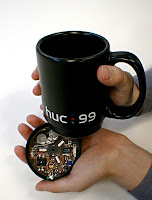Wolfgang visited us for 3 days and we talked a lot about context-awareness in the automotive domain. Given the sensors included in the cars and some recent ideas on context-fusion it seems feasible that in the near future context-aware assistance and information systems will get new functionality. Since finishing my PhD dissertation [1] there has been a move towards two directions: context predication and communities as source for context. One example of a community based approach is http://www.iyouit.eu which evolved out of ContextWatcher /IST-Mobilife.
 In his lecture he showed many examples how pervasive computing happens in the car already now. After the talk we had the chance see and discuss user interface elements in current cars – in particular the head up display. Wolfgang gave demonstration of the CAN bus signals related to interaction with the car that are available to create context-aware applications. The car head-up display (which appears as being just in front of the car) create discussions on interesting use cases for these types of displays – beyond navigation and essential driving information.
In his lecture he showed many examples how pervasive computing happens in the car already now. After the talk we had the chance see and discuss user interface elements in current cars – in particular the head up display. Wolfgang gave demonstration of the CAN bus signals related to interaction with the car that are available to create context-aware applications. The car head-up display (which appears as being just in front of the car) create discussions on interesting use cases for these types of displays – beyond navigation and essential driving information. In the lecture questions about how feasible / easy it is to do your own developments using the UI elements in the car – basically how I can run my applications in the car. This is not yet really supported 😉 However I had a previous post [2] where I argue that this is probably to come… and I still see this trend… It may be an interesting though how one can provide third parties access to UI components in the car without giving away control…
In the lecture questions about how feasible / easy it is to do your own developments using the UI elements in the car – basically how I can run my applications in the car. This is not yet really supported 😉 However I had a previous post [2] where I argue that this is probably to come… and I still see this trend… It may be an interesting though how one can provide third parties access to UI components in the car without giving away control…[2] Albrecht Schmidt. Will cars become a more open platform?



